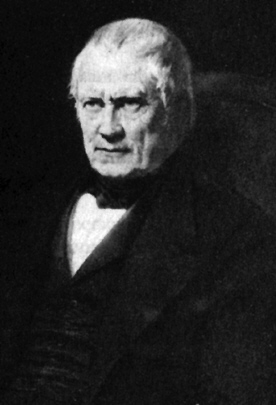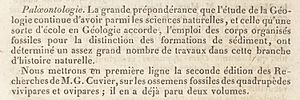Henri Marie Ducrotay de Blainville facts for kids
Quick facts for kids
Henri Marie Ducrotay de Blainville
|
|
|---|---|
 |
|
| Born | 12 September 1777 Arques-la-Bataille, France
|
| Died | 1 May 1850 (aged 72) |
| Known for | Taxonomic authority on zoological species |
| Awards | Member of the American Philosophical Society, Philadelphia and of the French Academy of Sciences; foreign member of the Royal Swedish Academy of Sciences |
| Scientific career | |
| Fields | |
| Institutions | Collège de France French Academy of Sciences |
| Influences | Georges Cuvier |
| Author abbrev. (zoology) | Blainville |
Henri Marie Ducrotay de Blainville (born September 12, 1777 – died May 1, 1850) was a famous French scientist. He studied animals (a zoologist) and the structure of living things (an anatomist). He was known for naming many animal species.
Contents
Early Life and Studies
Henri Blainville was born in Arques-la-Bataille, a town near Dieppe in France. When he was young, he moved to Paris to study art. However, he soon became very interested in natural history, which is the study of nature.
Becoming a Scientist
Blainville caught the eye of a very important scientist named Georges Cuvier. Cuvier was a leading expert in animal anatomy. Sometimes, Blainville would even teach classes for Cuvier at the Collège de France.
In 1812, with Cuvier's help, Blainville became an assistant professor. He taught anatomy and zoology at the Faculty of Sciences in Paris. Later, their friendship ended, and they became rivals.
Important Work and Discoveries
Blainville became a well-respected scientist. In 1819, he was chosen to be a member of the American Philosophical Society in Philadelphia. This was a big honor for him.
Joining Academies
In 1825, he joined the French Academy of Sciences. This is a group of France's top scientists. In 1830, he took over the natural history position at the museum from another famous scientist, Jean-Baptiste Lamarck.
Two years later, after Cuvier passed away, Blainville took over his position. He became the professor of comparative anatomy. This means he studied how the bodies of different animals are similar and different. He proved to be a great successor to his former teacher.
In 1837, he was also made a foreign member of the Royal Swedish Academy of Sciences.
Naming Animals
Blainville was very important in naming and classifying many animal species. He named both animals that are still alive today and those that are extinct (no longer living). One animal named after him is the Blainville's beaked whale, a type of whale found in the ocean.
Studying Reptiles and Amphibians
In the field of herpetology, which is the study of reptiles and amphibians, Blainville made important contributions. He agreed with another scientist, Pierre André Latreille, that Amphibia (like frogs and salamanders) should be separate from Reptilia (like snakes and lizards). He also described several new species of reptiles.
Coining "Paleontology"
Blainville also created a very important word in science. In 1822, he was the first to use the term "paleontology". This is the study of ancient life, especially through fossils.
Later Life and Legacy
Blainville did not believe in evolution, which is the idea that species change over time. He disagreed with Lamarck's ideas about how animals evolve.
On May 1, 1850, Blainville sadly passed away. He had a sudden illness while traveling on a train in Paris.
Animals Named in His Honor
Many species have been named after Blainville to honor his work. Some examples include:
- The North American lizard Phrynosoma blainvillii.
- A fossil fish called Aeduella blainvillei from the Permian period.
- The deep-bodied pipefish (Leptonotus blainvilleanus), a type of marine fish.
Key Publications
Blainville wrote many important books and papers during his career. Some of his notable works include:
- Sur les ichthyolites, ou, Les poissons fossiles (1818) - This book was about fossil fish.
- De l'organisation des animaux, ou Principes d'anatomie comparée (1822) - This work discussed the organization of animals and the principles of comparative anatomy.
- Manuel de malacologie et de conchyliologie (1825-1827) - A guide to malacology (the study of mollusks) and conchology (the study of shells).
- Ostéographie ou description iconographique comparée du squelette et du système dentaire des mammifères récents et fossiles (1839–64) - A detailed description of the skeletons and teeth of both living and fossil mammals.


